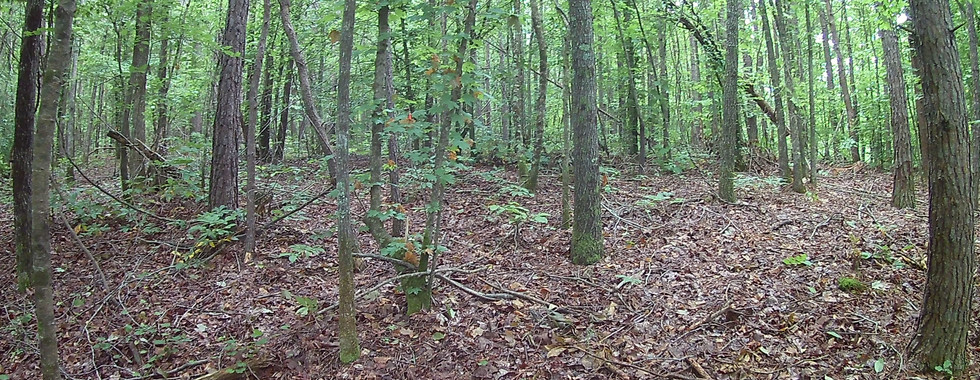Excavating the Mountain
- Steven and Ashley
- May 22, 2020
- 4 min read
TL;DR - Skip to the very end for time-lapse videos of the entire excavation!
Most of you probably aren’t familiar with the multiple years we spent searching for the perfect piece of land for our dream home. We had a lot of requirements on our wish list, including diverse terrain/biodiversity, at least one ideal build site, bluffs with climbable walls, water features, views, and—originally—south-facing slopes. When we finally discovered the Hundred Acre Wood in 2017, we found ourselves with the unexpected problem of simply having too many options for perfect build sites.
Finally, we narrowed it down to a single perfect site. It’s a rounded bluff with a wrap-around view into the hollow that is just breath-taking in the winter, and it’s within 100 yards of our tallest waterfall. Can you imagine passing up the chance to have a waterfall in your front yard? Even better, the location is nearly perfectly centered within our property, which is great for the added privacy. That beauty comes with a cost, though.
Building so far down a steep slope increases the danger and difficulty of not only working the site, but in getting materials to it. This means increases in cost and time. Fortunately, there was an old logging road that came very near to the site, so at least the initial road clearing was somewhat simplified by that. And, since we intended to rent heavy equipment to do the excavation ourselves, we had high hopes of completing it quickly and cheaply.
I swear we didn't just do this because we like playing in the mud.
Our design means excavating deep into the side of the slope in order to earth berm our home. Given that our excavation work on other projects (road building, water lines, etc) had been fairly simple, we were frustrated to learn that the perfect site we’d chosen happened to have very little loose soil. Once Steven dug away the first few feet of top soil with the backhoe, he ran into solid sandstone. It wasn’t just large discrete boulders; the place we’d chosen to build our home was solid bedrock the entire length of the bluff. That meant rather than a few days of backhoe and tractor work, we were looking at months of extensive rock breaking with even heavier equipment. This increased the difficulty, labor, and cost by five times what it would have been had we chosen one of the more accessible locations on the plateau of our property where solid rock was much deeper.
But if it meant having the home we’d always dreamed of, it was still worth it.
After discovering the hard way that a skid steer with breaker attachment wasn’t nearly powerful enough to make progress on the solid sandstone, we completed the brunt of the work with a large backhoe and powerful breaker. That monster machine made rubble out of the mountain at a rate that made it hard to clear the pit fast enough to keep digging. We eventually invested in a front loader for the tractor to help move the material, allowing us to work more in tandem. Though the payback will take years to recoup, a good bit of it will be paid back in short term on what would have been equipment rental costs. These rentals would have been not only for moving the rubble but also for upcoming house tasks such as the footer drains, backfill, infill, green roof cover, and even pallet unloading.
And in hindsight – we wished we’d gotten the front loader at the same time we’d purchased our tractor. There have been countless times where it would have made a job far easier. I’d rather not admit how many truckloads of gravel we’d shoveled by hand until that point.
There was another massive cost benefit to doing the heavy work ourselves: Since excavation of soil and rock generates a huge amount of material, we were able to build our quarter-mile access road with what we removed from the pit. In this case, it was a tiny amount of topsoil, a good bit of clay, and a massive amount of basketball-sized rocks. Our buildsite is a narrow space and at the time didn’t even have a good place to turn a vehicle around, so we had no room to otherwise pile it. And had we hired a contractor to do the excavation, we likely would have also had to pay more to haul the material off. Additionally, hiring a contractor would have meant having to have the road at least minimally in place to begin with, which would have required bringing in huge amounts of exactly what we were already having to remove from the excavation site.

So we built our road from the house up, bucket load by bucket load. The clay and rock made an excellent road base and allowed us to build the road up from the surrounding forest with a nice crown to shed water away. Yes, doing it this way did add a couple of months of work to our excavation (especially since we can only work on the weekends), but it saved us thousands of dollars on road construction.
We first broke ground on the house on November 20th, 2018 with the expectation that we’d be ready to start building footings by January. Ah, to have been so innocent and naïve! Karma heard our plans, laughed good and long while we discovered the sandstone in our way, and then sent us a record-breaking wet winter just for good measure. It rained so constantly that the weekends where the ground was dry enough to keep the backhoe from just sinking into the mud were few and far in between. We had no choice but to wait for the weather to cooperate to finish excavation. We finally finished excavation in mid-July, 2019, eight long months after we began.
The moral of the story? We learned that project schedules look great on paper, but go right out the window the second you break ground. Especially if Karma hears you bragging...

















Comments